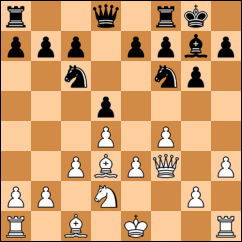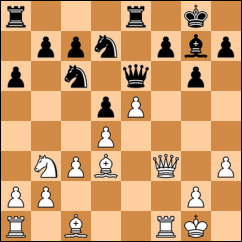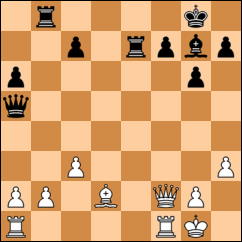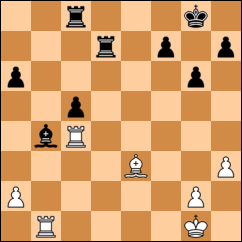R.Sharp–K.Ammann
Route 20 Chess Club
Freeport, Illinois, March 30, 2010
1.d4 d5 2.e3 Nc6 3.f4
Fritz throws up its virtual hands and calls this "1.d4 d5: Unusual lines"; ChessBase calls it a form of Bird's Opening. It's actually a Stonewall Attack, although Relton doesn't complete the formation until move 9. I've never seen a beast like this before, so I stick with basic opening principles while looking for a way to jam a pawn onto e5.
3...Nf6 4.Nf3 g6 5.Bd3 Bg7 6.Nbd2 Bg4 7.h3 Bxf3 8.Qxf3 0-0 9.c3
The Stonewall formation is complete. Also, the b4-square is now covered, preventing ...Nb4.
9...Re8 10.0-0 a6
Responding to the imaginary threat of Bb5. It's e4 I should be worrying about.
11.f5 Qd6 12.e4 e5 13.fxe6 e.p. Qxe6 14.e5 Nd7 15.Nb3
The base of Relton's pawn chain is invulnerable. All the action is on the kingside, but both my knights are marooned on the queenside. The d7-knight is stuck like a truck in the mud; the c6-knight has a path via e7-f5-h4, but it's slooooow. So it's not entirely without reason that I now succumb to a bit of hope chess: If I sacrifice a knight on e5, the other one has a chance to break through with tempo. If all goes well, I finish two pawns up. If not . . . well, you'll see. (For the record, Fritz's recommendation is 15...Rac8, which I don't even pretend to understand.)
15...Ncxe5 16.dxe5 Nxe5 17.Qe2
So instead of two pawns up, I'm down a piece for two pawns. It's enough, based on other considerations, to give Relton a decisive advantage.
17...Nxd3
Being at a material deficit, I should avoid exchanging, but on the other hand, the position is opening up, so I decide it's worth kamikazeing my knight in order to deprive Relton of a bishop.
18.Qxd3 Qe2??
Needlessly costs me two pawns. I could have defended the d-pawn with 18...Qb6+ 19.Kh1 Qb5, which also would have prevented the subsequent loss of b7.
19.Qxd5 Qe6 20.Qxb7 Qc4
Rather neat, I thought, defending all three of my weak pawns at once. I wasn't worried about the threat of Na5 -- you'll see why in a moment.
21.Bd2 Rab8 22.Qf3 Re7 23.Na5?
White can force a rook trade with 23.Rae1 -- black can't afford to allow 24.Rxe7.
23...Qc5+ 24.Qf2 Qxa5
"Good one," Relton acknowledged sheepishly. Now the game is even again -- but there are still a couple of problems I need to address. One is my pawn disadvantage on the queenside: somehow, I need to break up Relton's three pawns. The other is my f7-pawn, which is still weak and under attack. If I can solve both of these problems, I should at least draw.
Naturally, this is where I make a medium-size mistake. It's not a big mistake, but it's not insignificant, either.
25.Qa7 Rbe8
Given my analysis above, why do I pass up 25...Rxb2? Because of the threat of back-rank mate (for example, 26.Qa8+). For some reason, I have a mental block that stops me from seeing that the check can be parried easily with 26...Bf8. Thus, I settle for parity when I could enjoy a decisive advantage.
26.Bf4??
Relton obligingly recompenses my failure to seize the advantage by setting a trap for himself. 26.Rae1 Rxe1 27.Rxe1 Rxe1+ 28.Bxe1 would have held me to material equality in a position that slightly favors black.
26...c5!
The white queen is trapped!
27.b4!
A sharp parry. Do I take the pawn and let the big fish off the line, or do I accept an exchange of queens? As it happens, both options solve my pawn problem on the queenside. However, 27...cxb4!? 28.Qf2 Re2 29.Rae1 Rxe1 30.Rxe1 Rxe1+ 31.Qxe1 gives me a passed pawn on the sixth rank, making it the substantially better choice. In contrast, the sequence played leaves my passed pawn blockaded on the fourth rank.
27...Rxa7 28.bxa5 Bxc3 29.Rac1 Bxa5 30.Rc4
White can't play 30.Rxc5?? because of 30...Bb6.
30...Rc8
I'm better off seizing the b-file with 30...Rb7. Instead, I let Relton beat me to it.
31.Rb1 Rd7 32.Be3 Bb4??
A game-losing blunder. What's white's winning move? (Highlight to reveal answer.)
The pawn, being pinned, is a poor defender against 33.Rbxb4!. Nevertheless, Black's best reply is to trade rooks with 33...cxb4 34.Rxc8+ Kg7 -- though down a piece for two pawns, black still has superior pawn formations on both sides, so there's some small hope.
The denouement merits little comment:
33...Rd1+ 34.Kf2 cxb4 35.Rxc8+ Kg7 36.Rc4 b3 (36...a5 37.Bd4+ Kh6 38.Ke2) 37.axb3 Rd8 38.Ra4 Rb8 (38...Rd3 39.Rb4 Rd6 40.g4) 39.b4 Kf6 (39...g5 40.Bd4+ f6 41.Rxa6 Rxb4 42.Bxf6+ Kf7 43.Bxg5) 40.Rxa6+ Kf5 41.g4+ Ke5 42.Bc5 Kf4?? (42...Rd8 43.g5 Rd3) 43.Bd6+ 1-0








0 comments:
Post a Comment